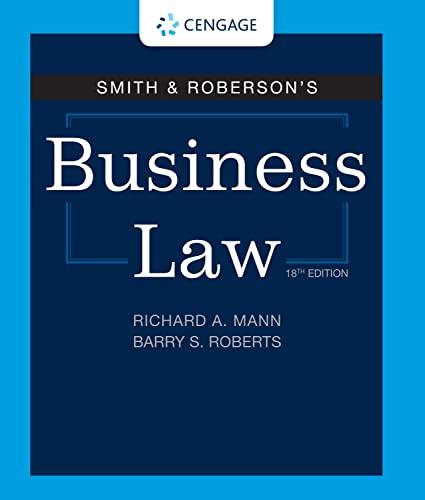Question
Read the following case study about Hemant K Mody's firing from GE and then answer the question prompts presented at the end. Use proper APA
Read the following case study about Hemant K Mody's firing from GE and then answer the question prompts presented at the end. Use proper APA formatting and include at least two references with their associated in-text citations. The essay must include an introduction, body, and conclusion. The minimum word count is 750, not including the title page and reference page.
Fear of Firing - The threat of litigation is making companies skittish about axing problem workers.
Would you have dared fire Hemant K. Mody? In February, the long-time engineer had returned to work at a GE facility in Plainville, Connecticut, after a two-month medical leave. He was a very unhappy man. For much of the prior year, he and his superiors had been sparring over his performance and promotion prospects. According to court documents, Mody's bosses claimed he spoke disparagingly of his co-workers, refused an assignment as being beneath him, and was abruptly taking days off and coming to work late. But Mody was also 49, Indian born, and even after returning from leave, he continued to suffer a major disability: Chronic kidney failure that required him to receive daily dialysis.
The run-ins resumed with his managers, whom he had accused flat out of discriminating against him because of his race and age. It doesn't take an advanced degree in human resources to recognize that the situation was a ticking time bomb. But Mody's bosses were fed up. They fired him in April. The bomb exploded in July 2006. Following a six-day trial, a federal court jury in Bridgeport, Connecticut, found GE's termination of Mody to be improper and awarded him $11.1 million, including $10 million in punitive damages. But the award wasn't for discrimination. The judge found those claims so weak that Mody wasn't allowed to present them. Instead, jurors concluded that Mody had been fired in retaliation for complaining about bias. GE sued to have the award overturned but was only able to get the award reduced by $5 million in 2007. Unfortunately, Mody never saw any of the 2006 jury award; he died in April 2007 of a heart attack.
If this can happen to GE, a company famed for its rigorous performance reviews, with an HR operation that is studied worldwide, it can happen anywhere. The result: Many companies today are gripped by a fear of firing. Terrified of lawsuits, they let unproductive employees linger, lay off coveted workers while retaining less valuable ones, and pay severance to nonperformers and even crooks in exchange for promises that they won't sue. The fear of firing is particularly acute in the HR and legal departments. They don't directly suffer when an underperformer lingers in the corporate hierarchy, but they may endure unpleasant indirect consequences if that person files a lawsuit.
When Mody signed GE's job application in 1998, the form said his employment was "at will" and "the Company may terminate my employment at any time for any reason." Well, not exactly. The notion that American workers are employed "at will" - meaning, as one lawyer put it, you can be fired if your manager doesn't like the color of your socks - took root in the laissez-faire atmosphere of the late 19th century and, as an official matter, is still the law of the land in every state, save Montana. For most American workers now, their status as at-will employees have been transformed by a succession of laws growing out of the civil rights movement in the 1960s that bar employers from making decisions based on such things as race, religion, sex, age, and national origin.
This is hardly controversial. Even the legal system's harshest critics find little fault with rules aimed at ensuring that personnel decisions are based on merit. Most freely acknowledge that it is much easier to fire people in the United States than it is in, say, most of Western Europe. Mass layoffs, in fact, are a recurring event on the American corporate scene. Yet even in these situations, RIFs, or "reductions in force," are carefully vetted by attorneys to assess the impact on employees who are in a legally protected category. These days the majority of American workers fall into one or more such groups. Mody, for example, belonged to three because of who he was (age, race, and national origin) and two more because of things he had done (complained of discrimination and taken medical leave). That doesn't mean such people are immune from firing. But it does mean a company will have to show a legitimate, nondiscriminatory business reason for the termination, should the matter ever land in court.
Questions
- Provide a summary of the specific employment laws you feel pertain to this case study.
- Based on the case study and employment law research, would you have fired Hemant K. Mody? Support your position with your resources.
- List three specific recommendations that you would give to managers to help them deal with the kinds of poor performance and diversity issues presented in this case study.
Reference:Ghillyer, A. (2012). Management now(2nd ed.). McGraw-Hill Education: New York, NY, 277-278.
Step by Step Solution
There are 3 Steps involved in it
Step: 1

Get Instant Access to Expert-Tailored Solutions
See step-by-step solutions with expert insights and AI powered tools for academic success
Step: 2

Step: 3

Ace Your Homework with AI
Get the answers you need in no time with our AI-driven, step-by-step assistance
Get Started


